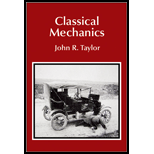
(a)
The maximum range in vacuum.
(a)
Answer to Problem 2.22P
The maximum range in vacuum is
Explanation of Solution
Write the expression for the range of the projectile.
Here,
Conclusion:
Substitute,
Therefore, the maximum range in vacuum is
(b)
The range in a given medium at an angle
(b)
Answer to Problem 2.22P
The range in a given medium at an angle
Explanation of Solution
Consider the linear drag.
The range can be solved from the following equation.
Here,
Conclusion:
Substitute,
Solve equation (III) to obtain the value of range,
Therefore, the range in a given medium at an angle
(c)
The range in a given medium for some selected values of
(c)
Answer to Problem 2.22P
The range in a given medium at an angle
Explanation of Solution
Use equation (II) to solve range for different values of
Conclusion:
Substitute,
Solve equation (IV) to obtain the value of range,
Substitute,
Solve equation (V) to obtain the value of range,
Substitute,
Solve equation (VI) to obtain the value of range,
Substitute,
Solve equation (VII) to obtain the value of range,
Substitute,
Solve equation (VIII) to obtain the value of range,
Therefore, the range in a given medium at an angle
(d)
To calculate range corresponding to smaller interval until the maximum range is obtained.
(d)
Answer to Problem 2.22P
The maximum range is
Explanation of Solution
Use equation (II) to find the range.
Conclusion:
Substitute,
Solve equation (IX) to obtain the value of range,
Substitute,
Solve equation (IX) to obtain the value of range,
Substitute,
Solve equation (X) to obtain the value of range,
Substitute,
Solve equation (XI) to obtain the value of range,
Thus from the above calculations the value of
Therefore, the maximum range is
Want to see more full solutions like this?
Chapter 2 Solutions
Classical Mechanics
 College PhysicsPhysicsISBN:9781305952300Author:Raymond A. Serway, Chris VuillePublisher:Cengage Learning
College PhysicsPhysicsISBN:9781305952300Author:Raymond A. Serway, Chris VuillePublisher:Cengage Learning University Physics (14th Edition)PhysicsISBN:9780133969290Author:Hugh D. Young, Roger A. FreedmanPublisher:PEARSON
University Physics (14th Edition)PhysicsISBN:9780133969290Author:Hugh D. Young, Roger A. FreedmanPublisher:PEARSON Introduction To Quantum MechanicsPhysicsISBN:9781107189638Author:Griffiths, David J., Schroeter, Darrell F.Publisher:Cambridge University Press
Introduction To Quantum MechanicsPhysicsISBN:9781107189638Author:Griffiths, David J., Schroeter, Darrell F.Publisher:Cambridge University Press Physics for Scientists and EngineersPhysicsISBN:9781337553278Author:Raymond A. Serway, John W. JewettPublisher:Cengage Learning
Physics for Scientists and EngineersPhysicsISBN:9781337553278Author:Raymond A. Serway, John W. JewettPublisher:Cengage Learning Lecture- Tutorials for Introductory AstronomyPhysicsISBN:9780321820464Author:Edward E. Prather, Tim P. Slater, Jeff P. Adams, Gina BrissendenPublisher:Addison-Wesley
Lecture- Tutorials for Introductory AstronomyPhysicsISBN:9780321820464Author:Edward E. Prather, Tim P. Slater, Jeff P. Adams, Gina BrissendenPublisher:Addison-Wesley College Physics: A Strategic Approach (4th Editio...PhysicsISBN:9780134609034Author:Randall D. Knight (Professor Emeritus), Brian Jones, Stuart FieldPublisher:PEARSON
College Physics: A Strategic Approach (4th Editio...PhysicsISBN:9780134609034Author:Randall D. Knight (Professor Emeritus), Brian Jones, Stuart FieldPublisher:PEARSON





